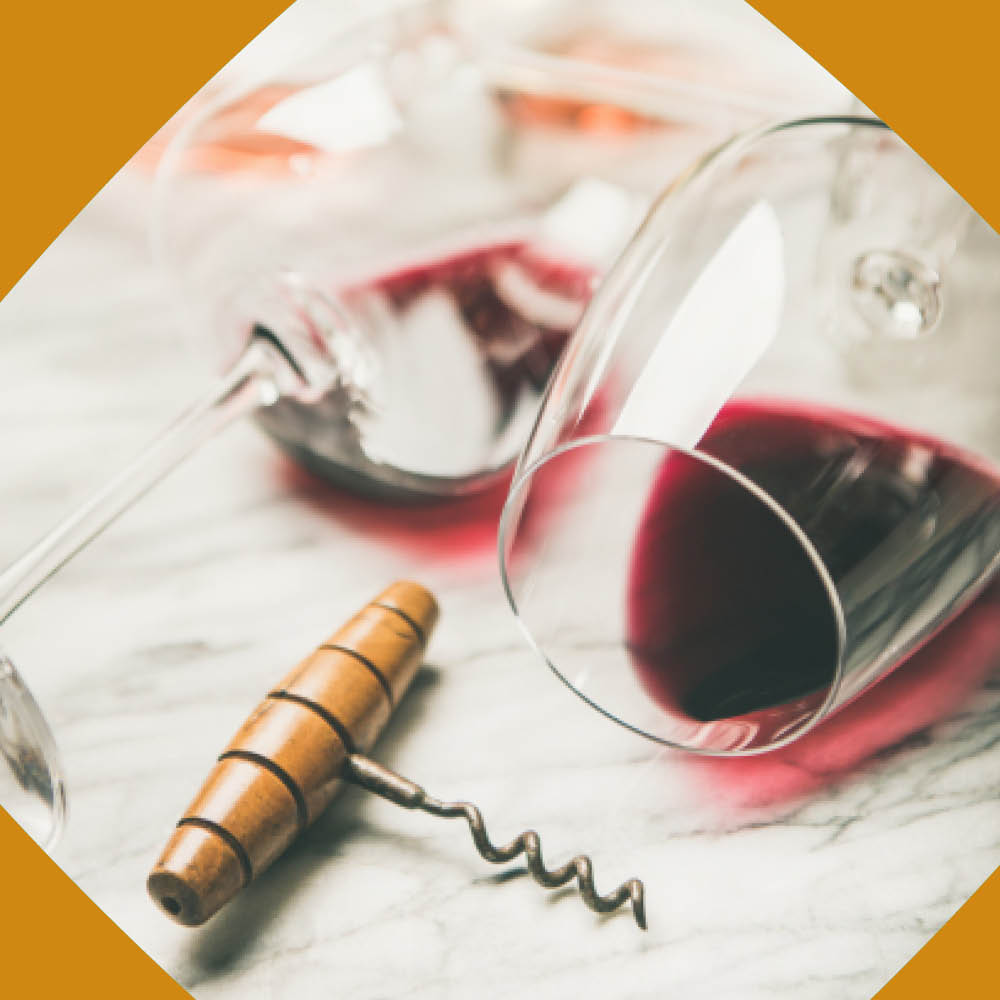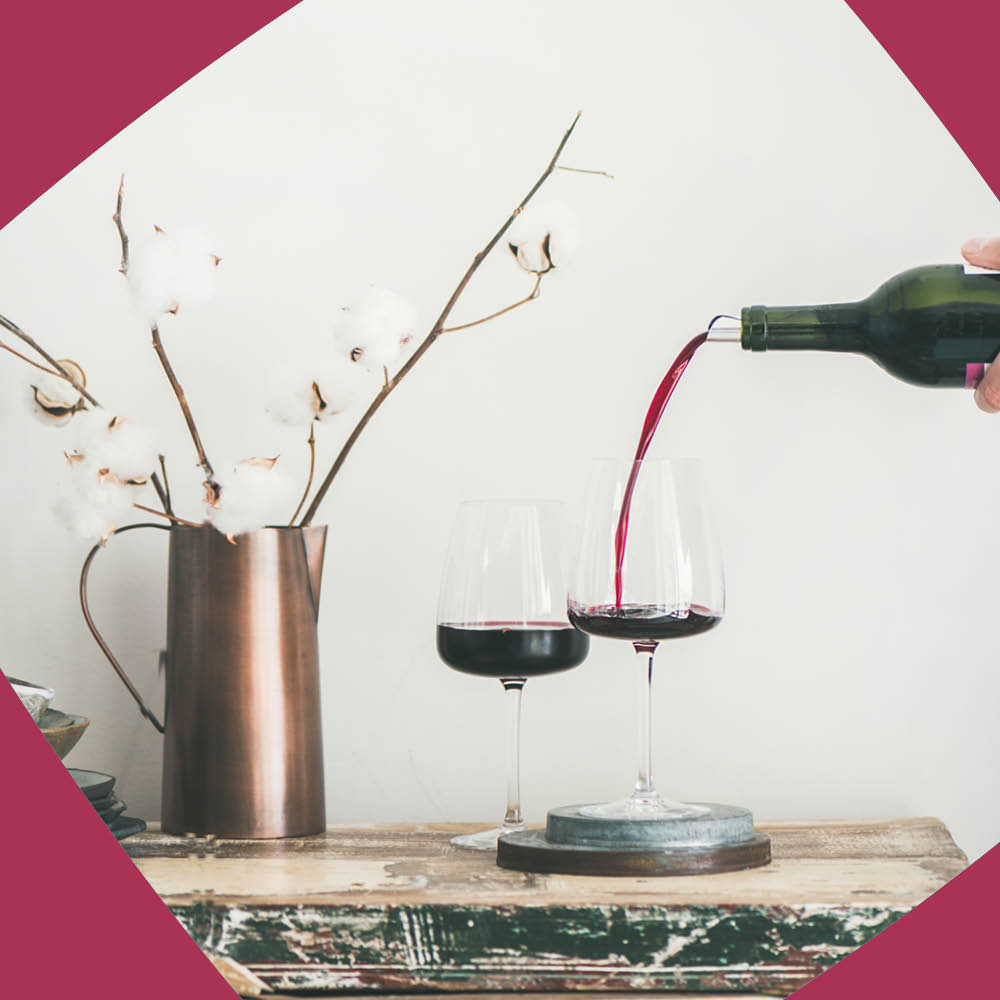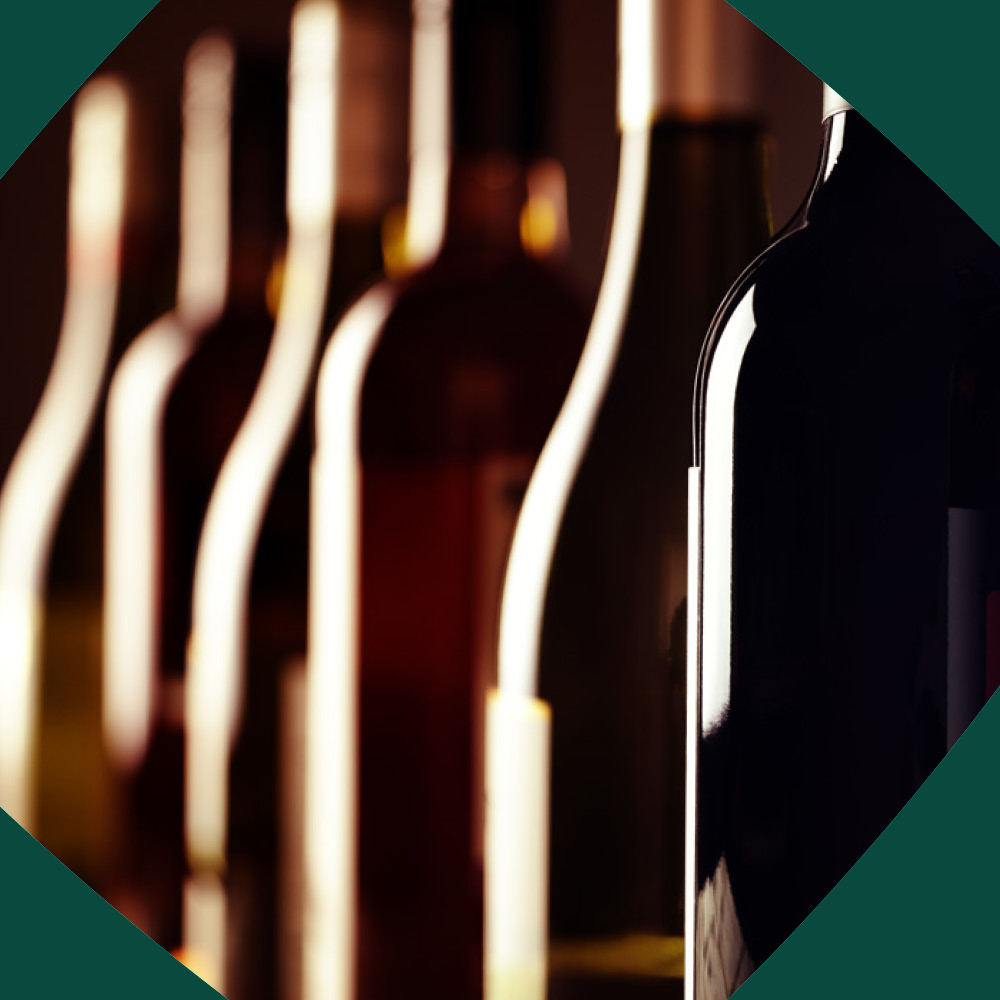Wine tasting guide
Taste wine like a master with Chief Wine Officer
If you don’t know where to start, wine tasting can seem like a complex and baffling pursuit.
We put together this guide to help you skip past the faking it stage and simply make it.
First things first
Bring your wine to temperature
If you’re tasting at home, it’s up to you to get your wines to the correct temperatures before serving.
*Full-bodied: More viscous mouth feel, alcohol typically at or above 13.5%
*Light: Thinner, lighter mouthfeel, alcohol typically at or below 12.5%
Red wines
Red wines should be aired before tasting and served at European room temperature.
Lighter: 15°C | 60°F
Full-bodied: 20°C | 68°F
White wines
White wines should be served cold. The lighter they are, the colder they should be served.
Lighter: 3-7°C | 38-45°F
Full-bodied: 7-12°C | 45-55°F
Rosés: 7-12°C | 45-55°F
Sparkling wine
Champagne and sparkling wine, like light white wines, should be nearly freezing cold.
Sparkling wines: 3-7°C | 38-45°F
Four steps to informed wine tasting
Step 1
Look
The opacity, colour, and viscosity of a wine can tell you a lot about what to expect. Lighter-bodied wines will tend to be less viscous, paler in colour, and less opaque, this can then be applied on a scale as you observe your selection of wines.
Step 2
Smell
When smelling wine, it’s best to start wide and then narrow your focus down to see if you can discern anything specific. Does it smell bready? Fruity? What kinds of fruits? Citrus? Lemon? Training your mind to think from out to in will help you identify individual elements in the flavour profile.
Step 3
Sip
This step can be broken into three – taste, texture, and length.
Taste is the discernment between sweet, salty, sour, bitter, and umami. The balance of these determines the wine’s flavour profile.
Texture, or mouthfeel, describes how your tongue and mouth experience your sense of touch, such as smooth, silky, rich, or dry. Tannins, for example, famously leave a drying mouthfeel.
Length refers to the amount of time the flavours remain on your palate after each sip. Over time, you’ll be able to discern how long a flavour lingers relative to other wines, building your understanding of wine length.
Step 4
Think
While every step requires thought, this last of the four steps is an opportunity to form an opinion of the wine. Was it balanced? Did the component smells and tastes fit well together? Was it too alcoholic or acidic? Did it linger or disappear right after swallowing? Was it a smooth sip? And lastly, did you enjoy it?
Glossary
A wine terminology for beginners
Wine is a wonderful gift from the South Caucasus people of 6000 B.C. But ever since those very first days of early viticulture, the terminology of making, tasting and appreciating wine has become infinitely more complex.
This glossary serves as a resource for anyone looking to grab wine by the neck and uncork all of its linguistic secrets.
Acidity
A word used to describe the acid level of a wine. Wines with high acidity will be tart or sour on the palate.
Aerate
Aeration refers to exposing a wine to the air outside the bottle for an extended period. Opening a bottle and letting it ‘breath’ is another way of referring to this process. This is why some wines are best enjoyed from a decanter, or you may be advised to let the wine breath in your glass for a short period before enjoying it.
Appearance
This refers to the clarity of the wine, not its colour. A wine’s clarity can tell you a lot about how it’s been made, as well as its body.
Appellation
The way a country categorises its wines by geopolitical boundaries. Each appellation, for example Nappa Valley in California, will have certain rules that govern which grapes can be used, where the grapes can be planted, and how the wines can be made. Some appellations have sub-appellations, such as Oakville, CA, a sub-appellation of Nappa Valley, and the rules that govern the wine made in Oakville will be more rigid than in the broader appellation it falls within.
Astringent
An astringent wine features a bite or harshness of flavour upon sipping, usually caused by acidity or tannins, standing out above the notes in the wine.
Backbone
Typically used to describe a well-balanced and full-bodied wine with a desirable level of acidity.
Balance
A balanced wine is one where each flavour component works with its counterparts harmoniously. No single element, such as alcohol, acidity, or tannins is dominant in a balanced wine.
Biodynamic
Biodynamic wines are made using centuries-old, anti-chemical methods that consider the relationship between farmers, the soil, the vines, and even the stars.
Blunt
A blunt wine displays a strong initial flavour and high alcohol content, but is lacking aromatic appeal or development on the palate.
Body
A wine’s body is an expression of fullness on the palate. This typically comes from the balance of sugar, alcohol, and glycerine in the wine, and can be described as full, medium, or light-bodied.
Bright
Used to describe wines that are zesty, fresh, ripe and often young with vivid flavour profiles.
Brilliant
A wine that is exceptionally clear with little to no suspended particulates, and often descriptive of highly filtered wines.
Chewy
A heavy, rich, and full-bodied wine with high tannin content.
Corked
A wine that has been infected by a bacteria called Trichloroanisole. Though harmless, a corked wine takes on a mouldy cardboard aroma and an unpleasantly dry aftertaste.
The world’s premier wine tasting and networking events company, headquartered in the heart of London. Can also be used to describe a C-suite executive who has attended the above event and bested their peers in a battle of wine wits to be crowned the evening’s ‘Chief Wine Officer.’
An exclusive global members’ society of C-suite executives who appreciate fine wine and luxury dining.
Decanting
Carefully and slowly pouring wine from its bottle into another container. Often done to separate the wine from sediment collected at the bottom of the bottle, or to allow the wine to breathe.
Depth
The more complex and concentrated the flavours are, the more depth a wine has.
Dry
This refers to a wine having no discernible taste of sugar. The opposite of sweet wine.
Earthy
An aroma and flavour descriptor used to denote tones of concrete, mould, mushrooms, potato, and earth in wine. When less pronounced, these are generally referred to as favourable attributes.
Edgy
Used to describe wines that are acidic or tannin-heavy in an intrusive manner, making for an inharmonious flavour profile.
Finish
A wine’s finish is its aftertaste, the flavours that linger longest after a sip. This is often considered among the most important characteristics of a wine, with the best having rich and complex finishes.
Gamey
A term used to describe meaty, earthy, and barnyard aromas in a wine.
Grand cru
A French term meaning ‘great growth’, it is used to classify wines produced in the highest-level terroir.
Heady
Used to describe high alcohol wines.
Hot
Used to describe wines with a high alcohol content that are unbalanced and burn with a heat on the finish.
Intrusive
A term used to describe an attribute of a wine that throws out the balance of flavour.
Ice wine
A wine made from grapes that have frozen on the vine. Typically, Ice wines are very sweet and are enjoyed as dessert wines.
Juicing
The term to describe the extraction of must from grapes without using external pressure, only the weight of other grapes that cause must to run freely from them.
Kava
A term of Greek origin that describes a wine that has been stored and matured over a lengthy or longer than usual period.
Lees
Lees are the byproducts of wine making and ageing that settle in the bottle or the vessel used to age the wine. This sediment plays an important role in developing complex flavour and mouthfeel, and some winemakers won’t filter wine from lees until right before bottling or at all.
Legs
The viscous droplets that run down the inside of the wine glass after wine has been swirled. This is an indication of either the alcohol content (high volume of droplets) or sugar content (slow falling legs).
Length
The length of time that the sensation of flavour and aroma linger after wine has been swallowed. Good quality wines typically linger for longer.
Master of Wine
Considered the most challenging wine certification to attain. A Master of Wine must display exceptional knowledge of the tasting, business, and making of wine in multiple regions. Only The Institute of Masters of Wine can award the title, and at the time of writing there are only 416 Masters of Wine in the world.
Master Sommelier
A diploma qualification that can only be attained from the Court of Master Sommeliers. This is the peak of expertise for wine experts in the hospitality industry. Master Sommeliers must display expertise across many criteria, including wine tasting, customer service, beverage service management, and sales. At the time of writing, there are 273 Master Sommeliers in the world.
Mouthfeel
The way a wine feels in the mouth, as opposed to its taste. This can refer to viscosity and the drying, lip-smacking tannins in red wines, for example. This term is often used interchangeably with texture.
Must
The freshly pressed grape juice that still contains the skins and stems of the grape. The next step in winemaking after harvesting the grapes.
Natural wine
Wine produced without herbicides or pesticides, and with little to no additives such as added yeast or sulphites. Natural wines are typically a product of smaller, organic and sustainable farms and are often made from hand-picked grapes.
Nose
The nose of a wine refers to the scents or aromas coming off the wine. Also referred to as the wine’s bouquet.
Oaky
Describing flavours associated with wines aged in oak barrels, including vanilla, mocha, cinnamon, baking spices, coconut, and dill.
Oenology
The scientific study of wine and winemaking.
Oxidation
Describing wine that has been exposed to open air and has undergone a chemical reaction that affects its flavour profile.
Peak
The time when a wine tastes its best. A subjective term referring to recommended drinking windows for wines of a particular vintage.
Perfumed
Describes a strong, sometimes sweet, often floral aroma emanating from some white wines.
Pét-nat
Wine made using the méthode ancestrale, a winemaking practice that predates the traditional method. This process involves bottling the wine while it is still fermenting to trap the carbon dioxide, creating a gentle carbonisation.
Quaffer
A pleasant, inexpensive, and easy-drinking wine designed to appeal to a mass market.
Rich
Full-bodied, well balanced, and well-rounded wines, typically on the sweeter end.
Round
Wines with a texture that is smooth throughout, not coarse or heavily tannic.
Rustic
A descriptor of wines that have been made using old-fashioned methodology or taste like wines made in earlier eras. Can be positive for wines that require aging before peaking, or negative for young wines that should be fresh and fruity.
Soft
A wine that is low in tannins and/or acidity, making for very easy drinking.
Sommelier
A trained and knowledgeable wine professional, usually working in restaurants and hospitality.
Structure
The interaction of a wine’s defining characteristics that contribute to texture and mouthfeel. These include alcohol, tannins, acidity, glycerine, and sugar.
Sulphites
Sulphites in wine refer to the presence of sulphur dioxide produced during fermentation and added sulphite compounds that are used as protection against wine oxidation and microbial instability.
Tannin
A lip-puckering and drying substance mostly found in red wines, derived from grape skins, seeds, and stems in the wine making process. These act as a natural preservative and aid in the aging and development of wine.
Terroir
How a wine region’s climate, soil, and terrain affect the taste of the wine.
Texture
Used interchangeably with ‘mouthfeel’, texture refers to the way a wine feels in your mouth. Common descriptions of texture include smooth, silky, coarse, velvety, or waxy, to name just a few.
Ullage
The space left in bottles and barrels by wine evaporating over time.
Velvety
A wine with a rich flavour profile and a smooth, luxurious texture.
Vintage
A wine’s vintage refers to the year in which the grapes were harvested. You may hear that “2021 was a great vintage” in South Africa for Chardonnay in the cape wine region, that means the grapes were of a particular quality and were allowed to ripen in preferential conditions. Vintage wines are made exclusively with grapes from a single harvesting year. Non-vintage wines often combine grapes from separate harvests.
Volatile
Descriptive of a wine with excessive or undesirable amounts of acidity, giving the wine a sour, vinegary edge.
Weight
A descriptive term for the wine’s ‘body’, used to denote a richness or thickness on the palate.
WSET
The Wine & Spirit Education Trust, a provider of globally recognised qualifications popular among wine experts around the world.
Xylem
Thick-walled tubes that transport water and nutrients in the soil from the roots to the tips of higher plants like vines.
Xeisuthros
The deity worshipped by the Chaldeans (100 BC) as the beneficent God of Wine.
Yield
The productivity of a vineyard, used to describe volume of grape harvests.
Young
A wine that is still early in the development of its flavour. Commonly attributed to wines that have been bottled within a year of their vintage and display clean, crisp, and lively notes.
Zork
A polyethylene wine closure consisting of a foil-wrapped synthetic cork that, once opened, can be replaced and resealed to help opened wine lengthen its shelf-life.
Discover more
Want to know more about our wine experts?
Our wine experts and Masters of Wine are some of the most knowledgeable, personable, and highly-qualified wine professionals in the world.
What to expect at a CWO event?
Exclusive industry insights, senior peer networking, and world-class wine tasting are standard.
Find an event that suits you
Our Chief Wine Officer events blend world-class networking with world-renowned wine tasting experiences.


